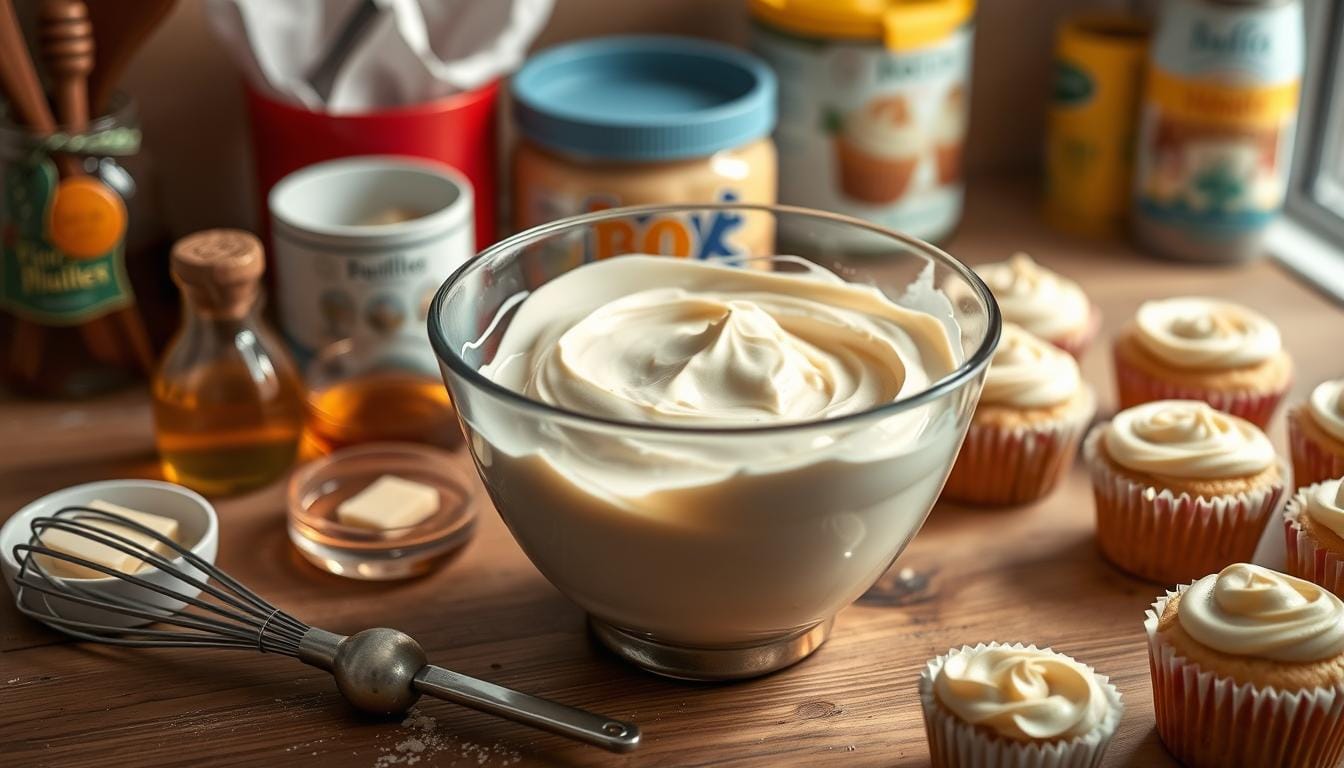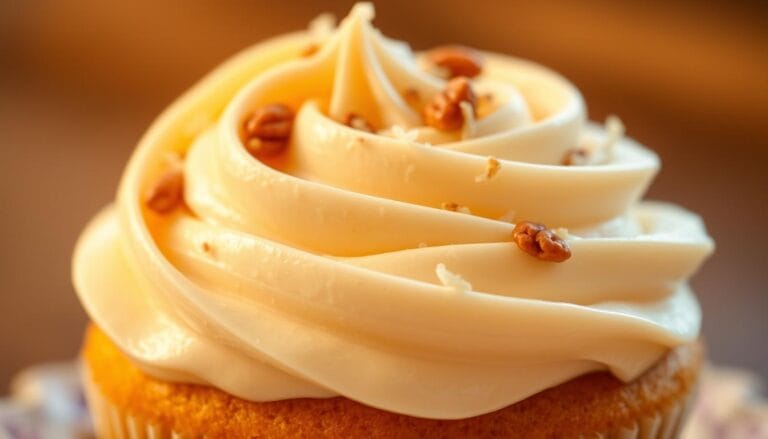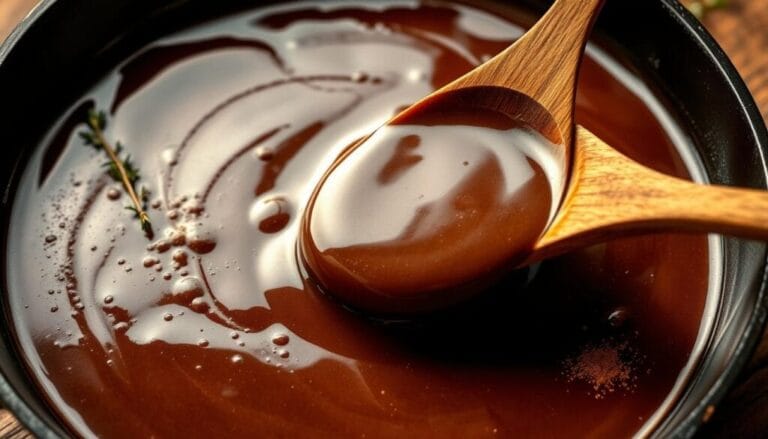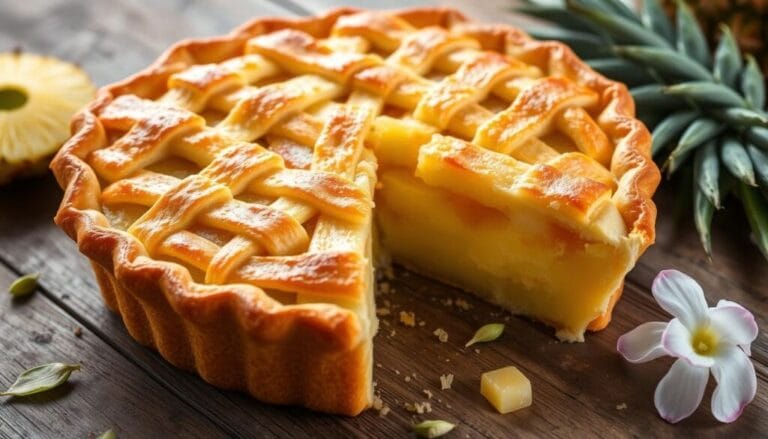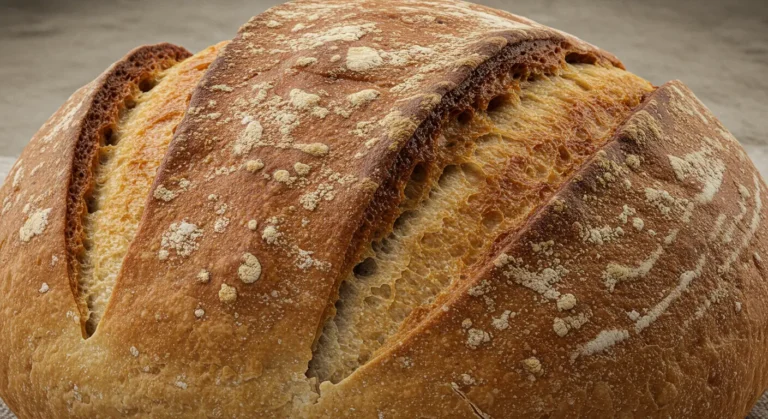How to make frosting recipe without powdered sugar
Looking for a frosting recipe without powdered sugar? You’re in the right spot. Making frosting without powdered sugar is simpler than you might think. With the right ingredients and techniques, you can whip up a smooth, creamy frosting.
A basic recipe includes milk, flour, butter, sugar, and vanilla extract. It’s a great starting point for your frosting journey.
To start making a frosting recipe without powdered sugar, first learn the basics of sugar-free frosting. With practice and patience, you’ll master making frosting without powdered sugar. You can create many delicious flavors.
Whether you’re new to baking or have experience, learning this skill will elevate your baking. It’s a valuable skill that will make your baked goods even better.
Table of Contents
Key Takeaways
- Learn how to make a frosting recipe without powdered sugar using simple ingredients like milk, flour, and butter.
- Discover the benefits of using a frosting recipe without powdered sugar, including a smoother texture and better flavor.
- Understand the importance of temperature control when making frosting without powdered sugar.
- Get tips and tricks for achieving the perfect consistency and flavor in your frosting recipe without powdered sugar.
- Explore different flavor variations and add-ins to take your frosting without powdered sugar to the next level.
- Learn how to troubleshoot common issues with your frosting recipe without powdered sugar, such as texture problems or uneven flavor.
Understanding the Basics of Sugar-Free Frosting
Making a frosting recipe without powdered sugar is key to understanding sugar-free frosting. Traditional frosting uses powdered sugar to prevent bacteria and mold. But, there are tasty alternatives that are just as good.
Sugar-free frosting is perfect for those who want to eat less sugar or follow special diets. It’s a healthier choice that doesn’t sacrifice taste.
Alternative frostings Opt for natural sweeteners like stevia or erythritol—lower-calorie alternatives to standard sugar They also let you use healthier ingredients like Greek yogurt or coconut cream. This creates a smooth, velvety finish for the frosting.
To start making sugar-free frosting, you’ll need a few tools. You’ll need a hand mixer, a whisk, and a measuring cup. Choose a sugar-free sweetener like Swerve or Allulose, and a natural flavor like vanilla extract. With these, you can make a tasty and healthy frosting for cakes, cupcakes, or cookies.
Some benefits of sugar-free frosting include:
- Lower calorie count
- Natural ingredients
- Reduced sugar intake
- Delicious and creamy texture
Learning about sugar-free frosting and its alternatives lets you make a delicious and healthy frosting. It’s great for any occasion, whether you’re cutting down on sugar or following a special diet. Sugar-free frosting is a tasty choice that everyone will enjoy.
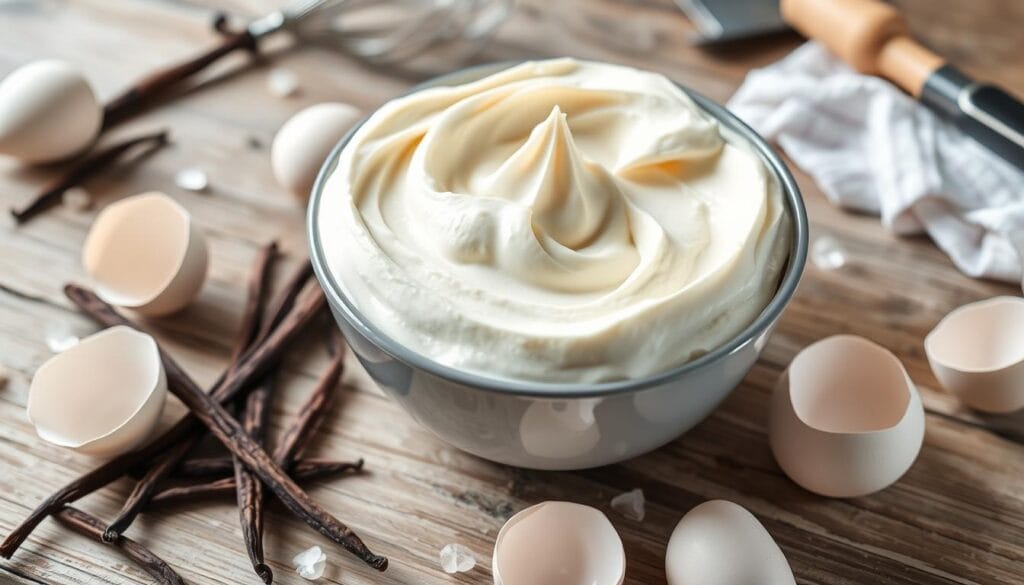
Basic Ingredients for Making Frosting Recipe Without Powdered Sugar
Making a frosting recipe without powdered sugar requires the right ingredients. You’ll need basic frosting ingredients like cream cheese, butter, granulated sugar, and vanilla extract. These help make a tasty and smooth frosting. The key is the sugar-to-cream cheese ratio, usually 1:2.
For a healthier frosting, consider sugar-free frosting ingredients like coconut butter or non-dairy milk. These options make your frosting delicious and better for you. For instance, use 1/2 cup of coconut butter and 1/2 cup of non-dairy milk for a low-sugar frosting.
- 1 tablespoon of maple syrup as a sweetener
- 1 teaspoon of vanilla extract for flavor
- A pinch of salt to balance the sweetness
These ingredients help you make a frosting that’s not only tasty but also unique. By using these frosting ingredients and sugar-free frosting ingredients, you can create the perfect frosting for any event.
The French Buttercream Method
To make a great French buttercream frosting, controlling the temperature is key. The method involves cooking sugar and egg yolks together before adding butter. This step needs careful temperature control to get the right consistency.
Temperature Control Tips
When making French buttercream, it’s vital to cook the egg yolk mixture to 59°C (138°F). This pasteurizes it. The mixture should also be heated to 70°C (158°F) for the best results. Use a thermometer to check the temperature.
Step-by-Step Instructions
To make French buttercream, you’ll need 4 egg yolks, ½ cup + 3 tablespoons (133 grams) of sugar, and 10 tablespoons + 1 teaspoon (185 grams) of butter. Cook the egg yolk mixture until it’s thick like pudding. Then, whip it on high for 3 to 5 minutes until it’s soft and fluffy.
Common Mistakes to Avoid
A common mistake is not cooking the egg yolk mixture to the right temperature. This can make the frosting too thin or too thick. Also, not whipping the mixture enough can result in a frosting that’s not light and fluffy.
How to Make Frosting Recipe Without Powdered Sugar Using Granulated Sugar
Using granulated sugar is a great way to make a frosting recipe without powdered sugar. Simply whip granulated sugar and butter together until it’s light and fluffy. This method is perfect for those who want to avoid powdered sugar.
To make this frosting, whip the sugar and butter for about 20 minutes. You can also add cream cheese, vanilla extract, or honey to make it even better. Here are some benefits of using granulated sugar frosting:
- Less sweet compared to powdered sugar frosting
- Can be made with simple ingredients
- Perfect for decorating cakes and cupcakes
Here is a simple recipe for granulated sugar frosting:
| Ingredient | Quantity |
|---|---|
| Granulated sugar | 2 cups |
| Butter | 1 cup |
| Cream cheese | 8 ounces |
| Vanilla extract | 1 teaspoon |
This recipe makes about 6 cups of frosting, perfect for an 8-inch round cake. You can store it in the fridge for up to 5 days or freeze it for up to 6 months. With this simple recipe, you can make a delicious frosting for your next baking project.
Creating Flour-Based Ermine Frosting
To make flour-based ermine frosting, start by cooking the base mixture. Mix flour and milk in a saucepan and heat until thick, about 2 minutes. Cool it to 70°F (21°C) before adding sugar for a smooth frosting.
Next, whip in the butter and sugar. Use a stand mixer with a paddle attachment. Whip the butter until it’s light and creamy, roughly 5 minutes. Then, add the cooled flour-milk mixture and whip until right.
Cooking the Base Mixture
Cooking the base mixture is key for flour-based ermine frosting. Mix 1 ounce of all-purpose flour (about 3 tablespoons plus 2 teaspoons; 28g) with 6 ounces (about 3/4 cup; 170g) of milk in a saucepan. Heat over medium heat, whisking constantly, until it thickens, about 2 minutes.
Whipping Techniques
Whipping the frosting needs technique. Use a stand mixer with a paddle attachment to beat the butter until creamy. Then, add the cooled flour-milk mixture and whip until right. Whip at 75°F (24°C) for a smooth frosting.
Remember, use high-quality ingredients like real butter and pure vanilla extract. Whip at the right temperature and use the right flour. Avoid over-whipping to prevent stiffness.
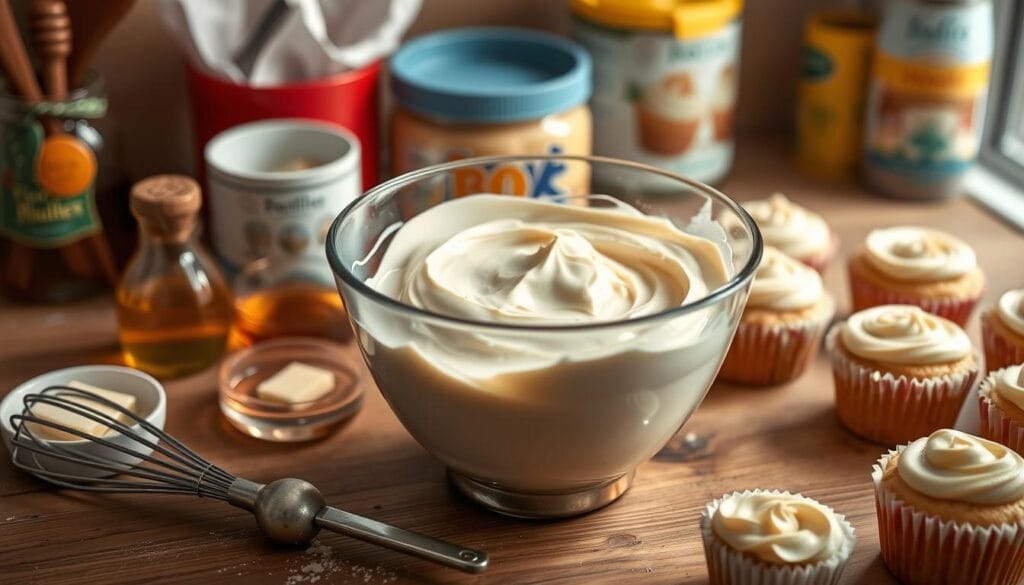
Swiss Meringue Buttercream Alternative
Swiss meringue buttercream is a favorite among frosting lovers. It’s made with egg whites, sugar, and butter. This gives it a lighter taste than regular frostings. You can use granulated sugar instead of powdered sugar to make it.
This frosting is great because it’s stable and can be used in many ways. You can add flavors like vanilla or lemon. It’s also easy to color, making it perfect for themed desserts. Plus, it doesn’t need powdered sugar, which is a big plus for those looking for different frosting options.
Here’s a simple recipe for Swiss meringue buttercream:
| Ingredient | Quantity |
|---|---|
| Egg Whites | 85 ml (approximately 1/3 cup + 1 tsp) |
| Granulated Sugar | 350 g (around 3 cups) |
| Unsalted Butter | 350 g (about 1.55 cups) |
| Salt | 1/4 tsp |
| Vanilla Extract | 1 tbsp |

By using this recipe, you can make a tasty Swiss meringue buttercream. It’s perfect for cakes and cupcakes.
Troubleshooting Your Sugar-Free Frosting
When you make sugar-free frosting, you might run into some common problems. These can include texture issues or sweetness that’s not quite right. To fix these, it’s key to know how to troubleshoot. This means finding out what’s causing the problem and making the right changes to get the frosting just right.
One big worry with sugar-free frosting is fixing texture issues. You can solve this by tweaking the ingredients. For example, if you’re using a granulated sweetener, you might need to add more liquid to get the right consistency.
Common Issues and Solutions
- Too thin: Add more sugar-free sweetener or reduce the amount of liquid.
- Too thick: Add more liquid or reduce the amount of sugar-free sweetener.
- Too sweet: Reduce the amount of sugar-free sweetener or add more acidic ingredients, such as lemon juice.
Another important thing is adjusting sweetness levels. You can do this by adding more or less sweetener, or by switching to a different sweetener. Think about the flavor you want, as different sweeteners can change how the frosting tastes.
By using these tips, you can fix your sugar-free frosting and get it just right. Always adjust the ingredients and sweetness to your liking and according to your recipe.
| Issue | Solution |
|---|---|
| Texture issues | Adjust the ratio of ingredients or change the type of sweetener |
| Sweetness levels | Adjust the amount of sweetener or use a different type of sweetener |
Flavor Variations and Add-ins
Now that you know how to make a frosting recipe without powdered sugar, it’s time to get creative. You can try different flavors and add-ins to make your frosting unique. This way, you can create a wide range of delicious frostings, from classic to innovative.
Popular flavors include chocolate, fruit-based options, and natural sweetener alternatives. For example, adding a teaspoon of vanilla extract or a pinch of salt can give your frosting a unique twist. You can also use different types of milk, like almond or soy milk, for a non-dairy frosting.
Chocolate Variations
Chocolate frosting is a classic favorite. You can make it without powdered sugar by using natural sweeteners like honey or maple syrup. Just melt the chocolate, mix it with the sweetener and heavy cream, and whip it until it’s light and fluffy.
Fruit-Based Options
Fruit-based frostings are perfect for spring and summer. You can make them by pureeing fresh fruit and mixing it with the frosting. For example, you can make a strawberry frosting by pureeing fresh strawberries and mixing it with the frosting. Or, you can make a lemon frosting by mixing in some freshly squeezed lemon juice.
Natural Sweetener Alternatives
Natural sweeteners like honey, maple syrup, and agave nectar are great for a more natural frosting. You can use these sweeteners instead of granulated sugar to create a delicious and unique frosting. Here are some examples of natural sweetener alternatives you can use:
- Honey
- Maple syrup
- Agave nectar

Remember, the key to making a great frosting is to experiment and have fun. Don’t be afraid to try new flavor variations and add-ins. And don’t worry if it doesn’t turn out perfectly the first time. With a little practice, you’ll be making delicious frostings like a pro!
| Flavor Variation | Ingredients | Instructions |
|---|---|---|
| Chocolate | Melted chocolate, natural sweetener alternatives, heavy cream | Melt the chocolate and mix it with the sweetener and heavy cream, then whip it until it’s light and fluffy |
| Fruit-Based | Pureed fresh fruit, frosting | Mix the pureed fruit with the frosting until well combined |
| Natural Sweetener Alternatives | Honey, maple syrup, agave nectar | Use in place of granulated sugar to create a delicious and unique frosting |
Best Uses for Different Types of Alternative Frostings
Choosing the right frosting for your cake or dessert is key. Alternative frostings offer many options. For instance, ermine icing is great for richer cakes like chocolate and golden vanilla, as well as cupcakes.
Here are some popular alternative frostings and their best uses:
- Whipped buttercream frosting: great for lighter desserts, such as cakes and cupcakes
- Flour-based ermine frosting: ideal for richer cakes, like chocolate cake and golden vanilla cake
- Swiss meringue buttercream: perfect for smoothing sheet or layer cakes
There are many alternative frostings to choose from. Every option brings distinct characteristics and ideal applications Knowing about these frostings helps you pick the right one for your next baking project.
| Frosting Type | Best Uses |
|---|---|
| Ermine Icing | Richer cakes, cupcakes |
| Swiss Meringue Buttercream | Smoothing sheet or layer cakes |
| Whipped Cream Frosting | Lighter desserts, cakes, cupcakes |
Conclusion: Mastering Your Homemade Frosting Skills
Making a frosting recipe without powdered sugar is a skill you can learn. This guide has shown you how. You’ve learned about French buttercream, ermine frosting, and Swiss meringue buttercream. These methods help you make creamy frostings for many cakes and desserts.
Understanding each ingredient’s role is key to making great frosting. Try new flavors and designs. Don’t worry about texture or sweetness problems. With practice, you’ll make frostings as good as those from a bakery.
FAQ
What are the basic ingredients needed for making a frosting recipe without powdered sugar?
To make frosting recipe without powdered sugar, you need milk, flour, butter, sugar, and vanilla extract. You can also use granulated sugar as a sweetener.
What is the French buttercream method for making a frosting recipe without powdered sugar?
The French buttercream method cooks sugar and egg yolks together. Then, you add butter. It needs careful temperature control and specific steps for success.
How can I use granulated sugar to make a frosting recipe without powdered sugar?
To make whipped buttercream frosting, whip sugar and butter together until fluffy. This creates a smooth and delicious frosting.
What is the flour-based ermine frosting method for making a frosting recipe without powdered sugar?
Flour-based ermine frosting cooks a base mixture. Then, you whip in butter and sugar. It has special techniques and storage tips.
What are some common issues to troubleshoot when making sugar-free frosting?
Issues like texture problems and sweetness adjustments are common. Temperature issues also need fixing.
How can I create unique flavor variations and add-ins for my sugar-free frosting?
Try chocolate, fruit, or natural sweeteners for unique flavors. This makes your frosting delicious and special.
What are the best uses for different types of alternative frostings?
Different frostings like whipped, ermine, and Swiss meringue suit different cakes and desserts. Choose the right one for your treat.
There are no reviews yet. Be the first one to write one.
